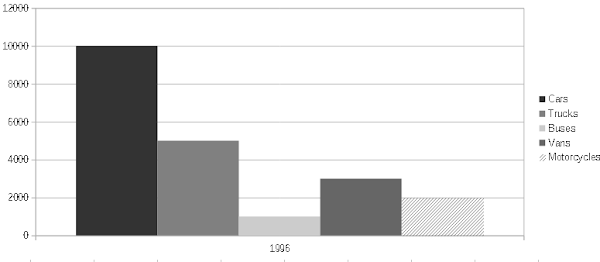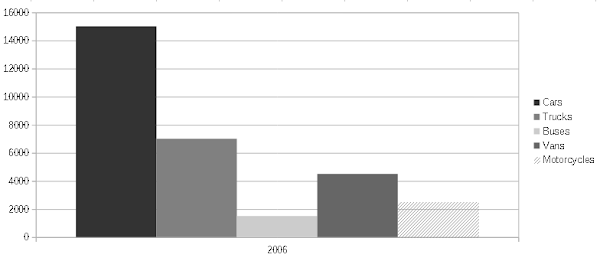How to Answer IELTS Academic Writing Task 1 | Describe a Graph
IELTS Academic Writing Task 1
"Summarise the information by selecting and reporting the main features and make comparisons where relevant."
Road-going Vehicles Registered in a European Country 1996 & 2006


Task 1 Sample Answer
The data illustrates how many roadgoing vehicles were registered in a European country in 1996 and 2006 across five categories: cars, trucks, buses, vans, and motorcycles. Overall, there was a noticeable increase in the total number of vehicles over the ten-year period.
In 1996, the country had 10,000 cars, 5,000 trucks, 1,000 buses, 3,000 vans, and 2,000 motorcycles. By 2006, these figures rose significantly to 15,000 cars, 7,000 trucks, 1,500 buses, 4,500 vans, and 2,500 motorcycles.
Cars constituted the predominant proportion of registered vehicles in both years, followed by trucks and vans. Interestingly, while there was a steady growth in the number of cars, trucks, and vans, the increase in buses was relatively modest. Motorcycles experienced the smallest increase overall.
In summary, the data highlights a substantial growth in registered vehicles over the ten-year period, with cars being the most prevalent vehicle type throughout, followed by trucks, vans, buses, and motorcycles, respectively.
IELTS Writing Task 1 Describing and Comparing Changes Over Time
Understanding and employing functional language to describe changes over time is a critical skill in IELTS Academic Writing Task 1.
When comparing data over a period, use a variety of expressions to convey trends accurately and enhance the richness of your written response.
For example, when indicating an upward trend, you may use phrases like:
- "increased significantly"
- "saw a sharp rise"
- "went up steadily"
If you're describing a decrease, consider expressions such as:
- "declined slightly"
- "fell dramatically"
- "dropped consistently"
When drawing comparisons between different categories, comparative phrases such as:
- "more than doubled"
- "remained stable"
- "experienced a modest growth"
For stark differences use:
- "a far greater number of"
- "substantially higher than"
Here's how you might use these phrases:
- The number of cars increased significantly, from 10,000 to 15,000, representing a 50% rise.
- Although there was an increase in registered buses, this was modest compared to that of vans, which saw a sharp rise.
- Despite a general upward trend, motorcycles saw negligible growth, with numbers rising slightly from 2,000 to 2,500.
Using varied functional language demonstrates your command of English to the examiner and creates a more engaging and clear depiction of the data presented.
Comments